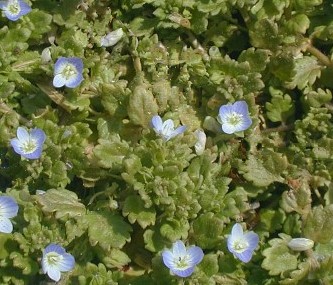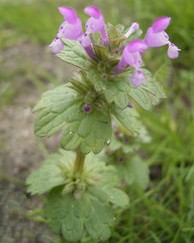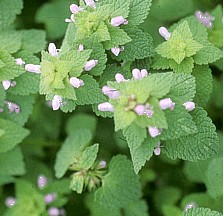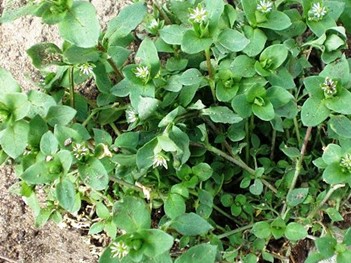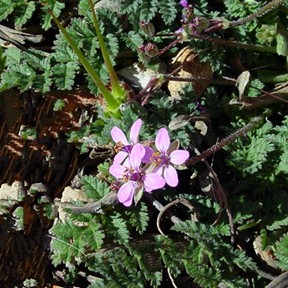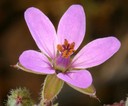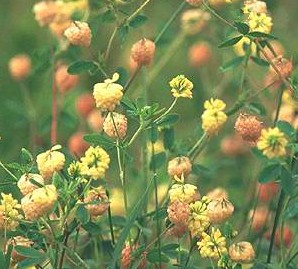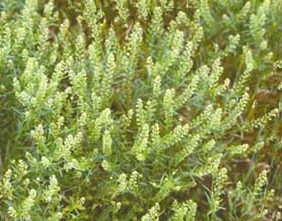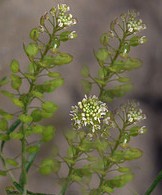Winter Annual Lawn Weeds
Winter annual lawn weeds are a common problem for lawn across the world. Almost no one is exempt. If you have all concrete, they will grow in the cracks. Learning to control them is the key.
Some weeds can be controlled by pulling them. For others, pulling them only spreads the plant more. Some are difficult to kill even with herbicides, but it can be done.
Introduction to
Winter Annual Lawn Weeds
Annual - is defined as a plant that germinates from seed, grows to maturity, produces seed and dies within a 12 month period. However, most annuals only live for half a year at best, with a few exceptions.
Annual weeds will either be “summer annuals” and “winter annuals”. Most winter annuals will germinate in late summer or fall, survive through the winter and grow quickly in the spring. The will produce seed and die by late spring or early summer.
Since winter annual lawn weeds die each year, they must come back the following year from seed. To ensure their survival, most annual lawn weeds produce an enormous amount of seed. Some plants can produce several hundred thousand seeds each year. They are quite successful since annual weeds are some of the most abundant weeds on earth.
Most lawn weeds don't like competition, winter annual lawn weeds are no different. So a thick lawn turf is your greatest defense against weeds. Focusing attention on weed control without building a thick turf is a guarantee you will have continued weed problems. For lawns in poor condition, it may take a couple of years of improvement before you see a major reduction in lawn weeds.
These winter annual lawn weeds listed on this weed identification page are not an exhaustive list and you may have other lawn weeds common to your geographical area. Be sure to check with your local university extension office for specific conditions in your area.
The Easiest Way of Controlling Annual Weeds
As mentioned, winter annual lawn weeds must start each year by seed. So keeping the seed from germinating means the weeds will not grow back. You need tow things: Knowing when they germinate and the right products to stop germination from happening.
Keeping weeds from germinating is done using Preemergents. All preemergents are not the same and some are better at stopping broadleaf weed seeds from germinating while others were developed to prevent grassy weeds from germinating.
For gardens and yards, Preen is an excellent choice for keeping broadleaf weeds out. But you need to apply the preemergent before the seeds germinate, so that means in late summer to early fall. If you apply it after weeds germinate it will do not good.
It also means you will not be able to overseed in the fall if you have cool season grasses. You will have to weigh the two options.
Corn Speedwell
- Winter annual with prostrate growth habit.
- A dense matt forming weed of thin or poor quality turf.
- Small rounded leaves no more than 1/2 inch in diameter.
- Small blue to purple flowers about 10mm across.
Weed Identification
Corn speedwell winter annual lawn weed is a spreading annual that germinates in the fall. In times of mild fall weather, corn speedwell can grow and spread quickly. If left untreated it can cover over a lot of ground. It survives the winter and then grows considerably more by mid-spring.
This is a plant that is seen mostly in poor quality turf and doesn’t compete well with thick turfgrass. It is primarily a prostrate growing weed that forms dense mats that grow close to the ground. In lawns where corn speedwell has been a problem, any condition that would lower turf quality only benefits the weeds and becomes more invasive.
Look for a plant with leaves positioned opposite each other along the base. However, farther up the stem, the leaves are smaller and set alternately on the stem.
The flowers of this winter annual lawn weed are a blue to purple color and very small, about 10mm across. The seed pods are heart shaped.
Cultural Practices
Speedwell can be a difficult plant to remove by mechanical means. The weed tends to break easily and leaving a lot behind.
In warm season grass, there is nothing to slow corn speedwell germination. By the time it germinates warm season grasses have gone or are going dormant. Thicker grasses such as zoysiagrass may only experience slight problems. In the spring, many warm season grasses can get very weedy until it breaks dormancy.
Building a thick healthy turf, whether in warm season grass or cool season grass, is the best way to discourage winter annual weed invasion.
Herbicide Use
You can use a preemergent in the fall to discourage seed germination.
The best time for post-emergent herbicide use is in the fall or early spring. Weeds are still young and growing making them easier to control. By mid-spring, the weeds have already hardened and are more tolerant of herbicides.
Use herbicides with 2,4-D, Dicamba, MCPP, or MCPA. A formulation with at least three of these ingredients will provide best control.
For a preemergent herbicide, use one with the active ingredient Pendimethalin. Others may also be labeled for corn speedwell.
Henbit
- One of the most common winter annuals.
- Square stems.
- Leaves positioned opposite each other on stem.
- Slender, tubular, pink flowers at the tips of stems.
- Spreads by seed.
Weed Identification
Henbit, sometimes confused with purple deadnettle, is a common winter annual lawn weed with an upright growth habit. It is at full height in April and May. It grows in moist soils and can reach heights of 12 inches by mid-spring. One of the unique characteristics of this plant is its square stems.
The leaves are positioned opposite each other along the stem. They are rounded with rounded tooth edges and each set makes a circle (whorl) around the stem. There is a small space between each set of leaves so that a small amount of stem is clearly visible.
The flowers are slender and tubular shaped with two lips opposite each other on the flower’s top. The flowers are pink to purple and can be ½ to ¾ inches long. The flowers arise from between the leaf whorls on the tip of the stems.
Cultural Practices
Henbit, like many winter annuals, does not compete well with thick turf. It prefers thin or poor quality turf best. Dormant warm season grass may have a problem with henbit in the spring. However, in newly seeded lawns, henbit can be a major problem weed. In small patches, pulling may offer some relief. Henbit can survive until May and then dies back until germination in the fall.Herbicide Use
Herbicides need to be applied in early spring. Using a formulation designed for the cooler temperatures in spring is desirable. In late spring the plants have harden being near the end of their life, so they will be less susceptible to herbicides. I can say from experience that Henbit can be hard to kill, so spray as soon as you see them.
As a basic rule, similar lawn weeds can usually be controlled by the same herbicide mixture. This is also true with the two lawn weeds, henbit and the similar looking plant, purple deadnettle. (in photo on left
Using a 3 or 4 way herbicide formulation (3 or 4 herbicides mixed together) will provide best results. Using 2,4-D, Dicamba and MCPP will control henbit.
Common Chickweed
- A winter annual that grows best in shaded areas.
- Grows in mounds 5 to 7 inches tall.
- Small white flowers with 5 deeply lobed petals.
- Can be easily pulled up by hand.
- Gets it name when it was used as a starter food for young chickens.
Weed Identification
Common Chickweed is a winter annual lawn weed that prefers moist sites. It is common to see it growing in gardens, mulch beds under trees or on the shaded side of homes. It loves bare ground and areas of thin turf. I haven't seen it often in thick turf.
It has a good cold tolerance and can survive temperatures near 0 degrees. It will bloom all winter even when temperatures dip several degrees below freezing.
It has a shallow root system making it easy to be pulled up by hand. The plant has weak stems that cannot stand well on their own. They must lean on other limbs to form a mound. The limbs that touch the soil will root at the nodes.
The mature leaves are approximately ½ inch long with a smooth texture. An interesting fact about the leaves is that they fold up around the stem at night.
The flowers grow in clusters on a long stalk starting from the leaf axils. There are five white petals on each flower. However, each petal is deeply lobed which gives it the look of ten petals.
Cultural Practices
Chickweed grows in moist, shaded soil. It is found on shaded hillsides, shady side of lawns, mulch placed under trees and related sites. It will grow in sunny areas as long as the temperature remains cool.
The primary way of preventing chickweed from establishing is to build a thick, vigorously growing lawn. Mowing your grass at its tallest recommended height will help as well. Many winter annual lawn weed will not compete with a thick lawn.
Taller mowing heights promote deeper rooting and strengthens grass.
However, warm season grasses may experience problems with weeds before it breaks dormancy. The grass offers no resistance and is also at its thinnest before dormancy.
Herbicide Use
Several herbicides are labeled for control of common chickweed. Products containing 2,4-D plus Dicamba will control it. For its close relative mouseear chickweed, the same mixture will also work well. Using a formulation of at least three herbicides will give better control and also help control other lawn weeds in your lawn.
A preemergent can be applied in the fall before seeds germinate. If you are planning to overseed your lawn, you shouldn’t use a preemergent. If you do, your grass seeds won’t germinate. Several products available to homeowners are labeled for common chickweed including “pendimethalin”.
Redstem Filaree
- Listed as a noxious weed in many states.
- Deeply lobed leaves that somewhat resemble a fern.
- Small, brightly colored five petaled flowers.
- Strong, but not unpleasant smell.
- Seed pods resemble a bird’s beak.
"Redstem Filaree photos by Steve Matson, 2004"
Weed Identification
Redstem filaree, also called California filaree and redstem stork’s bill, is considered an invasive and noxious weed in many states. It is a low growing winter annual lawn weed that has both a taproot and fibrous root system. After germination, it begins growing in a rosette pattern and can either continue growing prostrate or in an upward fashion.
Redstem filaree has hairy and reddish colored stems. The leaves are deeply lobed and attach alternately on the stem with no petioles. Some other species of filaree have leaves that are not quite so lobed. Because of the shape of the leaves, it is often confused with a similar looking weed called Carolina Geranium.
The flowers of redstem are pink to purple, approximately ½ wide with 5 petals. It flowers profusely in the spring and to a lesser degree through fall. The seed pods resemble a bird’s beak and tend to grow together in clusters. As the pods mature, the tops often curl like a pig’s tail.
Cultural Practices
Redstem Filaree is a common weed on roadsides, fields, and poor quality lawns. It can be found in much of the U.S., including semi-desert climates. The best way to keep this weed out of lawns is to work on building a thick, healthy turf. Most lawn weeds cannot compete with thick turfgrass. The plant can be pulled by hand since it doesn’t root at the nodes.
Herbicide Use
Many homeowner herbicides do not do a great job at controlling this weed. The effects are marginal. Using common herbicides as 2,4-D plus Dicamba can offer some control, but not exceptional. Look for formulation with at least three different herbicides mixed together for better effect. Adding a “sticker/spreader” to the herbicide mixture increases it effectiveness in controlling lawn weeds. It works by binding the herbicide to the plant which aids in the absorption. (See the page on Herbicides for more information.)
Small and Large Hop Clover
- A common forage crop, but also grows extensively throughout the U.S.
- Low growing cool season annual with yellow globe flowers.
- Stems are green to reddish colored.
- Leaves consist of three leaflets.
Weed Identification
Large and small hop clover are very similar except that large hop clover, like the names sounds, is just a little larger. All annual clovers, including it relative black medic, are low growing. In unmowed areas, such as hillsides or pastures, it can grow more upright, extending a foot or more in height.The leaves alternate and consist of three leaflets. The center leaf is on its own petiole. The stems feel a bit woody and are green to reddish (small hop clover) in color.
The flowers are globular and grow in clusters. In mowed turf, the plant tends to grow prostrate with stems laying flat on the ground. Large and small hop clover spread by seed.
Cultural Practices
Since this species of clover prefers fields and other low maintenance areas, working on a thick turf will keep most of it out. If your lawn is in poor condition, it may take a couple of years to get it where you see a major reduction in lawn weeds. Pulling or hoeing may reduce the amount of lawn weeds present, but seeds are in the soil guaranteeing another crop in the fall. Applying Preen or similar preemergent at the proper time helps.
Herbicide Use
Herbicides may be the quickest means of controlling this weed. Since it is an annual, a preemergence may be useful to prevent the seeds from germinating. It will need to go down before the seeds germinate. After germination, preemergents will have no effect.For growing weeds, a post-emergent broadleaf herbicide will need to be used. Look for herbicides with a three or four herbicide mixture for best control. Dicamba with MCPP or MCPA should help give some control. Check the label to make sure it lists your target weed.
Virginia Pepperweed
- Winter annual lawn weed found throughout most of the U.S.
- It prefers dry soil conditions in full sun locations.
- The stems grow erect and are multi-branched.
- Leaves grow alternately on the stem.
- Almost all seeds germinate in late summer or fall.
Weed Identification
Virginia Pepperweed is a small mustard-like winter annual that develops from a taproot. As with most annual lawn weeds, it is found in poor quality lawns, roadsides, gardens, and low maintenance areas. It forms a rosette pattern when young, but later develops upright stems. As it matures, it looses its basal leaves.The leaves are toothed over most of the leaf. However, near the base of the leaf it becomes lobed. The leaves on the stem are arranged alternately.
One of the identifying marks is its seed pods. The seed pods look like tiny lily pads. They are round, but flattened disks that attach near the top of the stem. At the top of the stems are clusters of tiny white flowers with four petals.
Cultural Practices
Since the plant grows from a taproot it is possible to pull them up by hand. Since it is associated with poor quality turf, working on a thick turf will keep this weed and most other weeds out.Herbicide Use
If you had problems with Virginia pepperweed before, there will be seeds in the soil from previous crops. Using a preemergent herbicide in late summer will work to stop weed seeds from germinating. Isoxaben is labeled for Virginia pepperweed. However, keeping lawn weeds out of bare soil is a difficult task even with a preemergent.
For established weeds you will need a post-emergent herbicide. Several herbicides are labeled for controlling this weed including 2,4-D, Dicamba, MCPP, MCPA, triclopyr plus clopyralid and others. Many herbicides will be formulated with 3 or 4 different herbicides for best control of weeds. Make sure the herbicide you use lists the target weeds on the label.
Use herbicides according to label instructions. Always be safe. Make sure you wear all personal protective equipment (PPE) listed on the label.
Crabgrass and Foxtails- Annual Grassy Weeds
Crabgrass and Foxtails are two major annual grassy weeds that can cover your lawn. You will find detailed information on their growth habits and how to control them before they even start.
Broadleaf Summer Annual Lawn Weeds
Many of the most problematic lawn weeds are annuals. Here you will find specific summer annual weed information, with weed names, photos and control methods.
Perennial Broadleaf Weed Identification Page 1
Click here for weed identification and control of common perennial lawn weeds. This page has detailed information on Canada Thistle, Mouseear Chickweed, White clover, Dandelion, Field Bindweed, Ground Ivy and Common Mallow.
Perennial Broadleaf Weed Identification Page 2
Click here for perennial weed identification and control. You can find detailed information on Buckhorn Plantain, Broadleaf Plantain, Red Sorrel, Wild Violets, and Common Yarrow.
Yellow and Purple Nutsedge
Nutsedge is a summer perennial grass-like weed. They can be particular problematic since they cannot be controlled by broadleaf weed herbicides. Click here for weed identification, growth habits and control methods.
Go from Winter Annual Brosdleaf Weeds back to Lawn Care Academy Home
